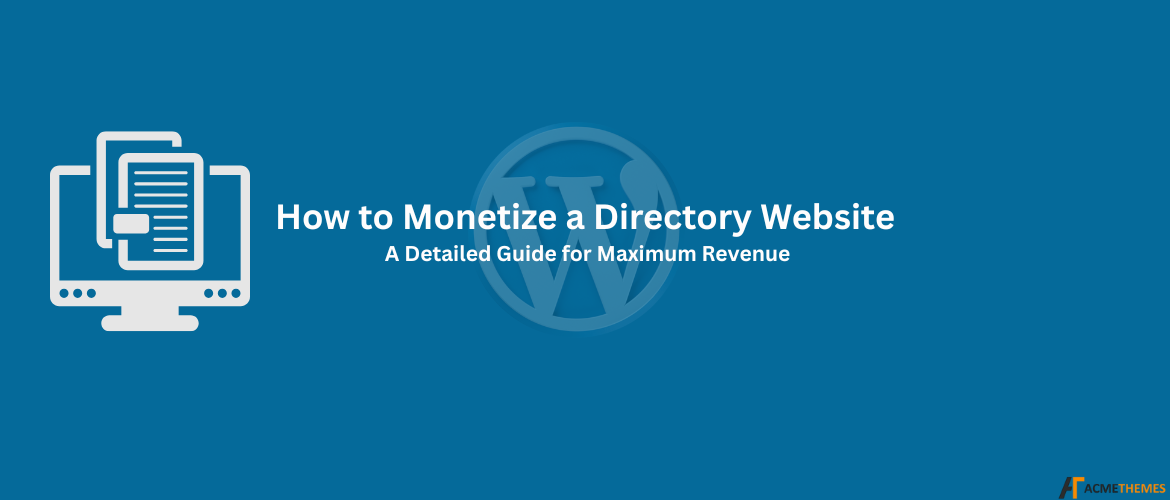How to Monetize a Directory Website: A Detailed Guide for Maximum Revenue
Directory websites serve as centralized hubs where users can find businesses, services, or resources in a specific niche. Whether you operate a local business directory, job board, real estate listing site, professional network, or niche directory, monetizing it effectively can generate consistent income while providing value to users.
In this comprehensive guide, we’ll explore multiple proven monetization strategies, their implementation, pricing models, and best practices to maximize earnings from your directory website.
Table of Contents
1. Premium & Featured Listings (The Most Profitable Model)
How It Works:
- Free Basic Listings: Allow businesses to add their listings with minimal details (name, contact, website).
- Premium Listings: Charge businesses for enhanced visibility (e.g., top placement, bold text, logo, extra fields like videos, social links).
- Featured Listings: Offer a “Sponsored” or “Editor’s Pick” section on the homepage or category pages for maximum exposure.
Pricing Strategies:
- One-Time Fee (e.g., $50 for a permanent listing)
- Recurring Subscription (e.g., 10/month or 100/year for premium placement)
- Tiered Pricing (e.g., Bronze: 5/month,Silver:15/month, Gold: $30/month)
Best For:
✅ Business directories (restaurants, contractors, doctors)
✅ Real estate & rental directories
✅ Job boards
Implementation Tips:
✔ Use WordPress plugins like Directorist, GeoDirectory, or Business Directory Plugin to manage listings.
✔ Offer a free trial (e.g., 7 days as a featured listing) to encourage upgrades.
✔ Highlight premium listings with badges (e.g., “Verified,” “Top Choice”) for credibility.
2. Pay-Per-Lead (PPL) or Pay-Per-Click (PPC) Model
How It Works:
- Pay-Per-Lead (PPL): Charge businesses when a user submits a contact form, calls, or requests a quote.
- Pay-Per-Click (PPC): Charges advertisers when users click on their listings (similar to Google Ads).
Pricing Examples:
- 1−5 per lead (depending on industry value)
- 0.10−0.50 per click (for high-intent niches like legal or financial services)
Best For:
✅ Service-based directories (lawyers, tutors, freelancers)
✅ B2B lead generation directories
Implementation Tips:
✔ Use call tracking software (e.g., CallRail) to measure leads.
✔ Offer lead guarantees (e.g., “Minimum 20 leads/month or money back”).
3. Advertising & Banner Ads (Passive Income Stream)
Types of Ads:
- Google AdSense (Easy set up, but lower earnings)
- Direct Ad Sales (Sell banner spots to local businesses for higher CPM)
- Affiliate Marketing (Promote relevant products/services for commissions)
Ad Placement Strategies:
- Header & sidebar banners (high visibility)
- In-content ads (between listings)
- Sticky footer ads (for better engagement)
Best For:
✅ High-traffic directories
✅ Niche directories (e.g., wedding vendors, travel guides)
Implementation Tips:
✔ Use Ad Manager plugins (e.g., Advanced Ads for WordPress).
✔ Offer ad bundles (e.g., “3 months for the price of 2”).
4. Membership & Subscription Plans (Recurring Revenue)
How It Works:
- Free Tier: Basic search, limited listings.
- Paid Membership: Unlock advanced filters, messaging, or premium content.
Pricing Models:
- 5−20/month for individual users
- 50−200/month for businesses (unlimited listings)
Best For:
✅ Professional networks (e.g., freelancers, consultants)
✅ Exclusive directories (e.g., luxury real estate, private clubs)
Implementation Tips:
✔ Use membership plugins (e.g., MemberPress, Paid Memberships Pro).
✔ Offer annual discounts (e.g., “Get 2 months free if paid yearly”).
5. Sponsored Content & Native Advertising
How It Works:
Businesses pay to publish articles, guides, or promotional posts within your directory.
Examples:
- “Top 10 Best Restaurants in [City]” (Sponsored by local eateries)
- “How to Choose the Right Lawyer” (Paid by a law firm)
Pricing:
- 50−500 per post (depending on traffic)
Best For:
✅ Niche directories with engaged readers
✅ Local business directories
Implementation Tips:
✔ Clearly label sponsored posts as “Promoted” or “Sponsored” for transparency.
6. Lead Generation & Data Sales (High-Value Monetization)
How It Works:
- Sell verified leads (e.g., “100 new homebuyers this month”).
- Offer market reports (e.g., “Trends in Local Business Listings”).
Best For:
✅ B2B directories
✅ Real estate & recruitment sites
Implementation Tips:
✔ Use CRM integrations (e.g., HubSpot, Salesforce) to track leads.
7. Freemium Model with Paid Upgrades
How It Works:
- Free listings with basic details.
- Paid upgrades for extra images, videos, or contact forms.
Best For:
✅ Job boards
✅ Event directories
8. Transaction Fees & Commission-Based Model
How It Works:
- Take a % fee on bookings (e.g., 5% per hotel booking).
- Charge a flat fee per transaction (e.g., $1 per job application).
Best For:
✅ Booking platforms
✅ Freelance marketplaces
9. White Label & Licensing (For Developers)
How It Works:
- Sell your directory theme/plugin (if built on WordPress).
- Offer SaaS licensing for businesses to create their own directories.
Best For:
✅ Developers with custom directory solutions
10. Events & Webinars (Engagement-Based Revenue)
Examples:
- “Local Business Expo” (Charge for booth listings).
- “Industry Networking Webinar” (Sell tickets).
Best For:
✅ Professional and B2B directories
Final Tips to Maximize Earnings
✅ SEO Optimization → More traffic = more monetization opportunities.
✅ Upsell Strategically → Offer tiered pricing for listings.
✅ Email Marketing → Promote premium listings to free users.
✅ A/B Test Pricing → Experiment with different models.
Conclusion
The best monetization strategy depends on your niche, traffic, and user engagement. Start with 1-2 methods, track performance, and scale up.
For WordPress directory themes & plugins, check out Acme Themes!
Which monetization method will you try first? Let us know in the comments! 🚀
I hope you enjoyed reading this article!
Please check out our other recent article:
